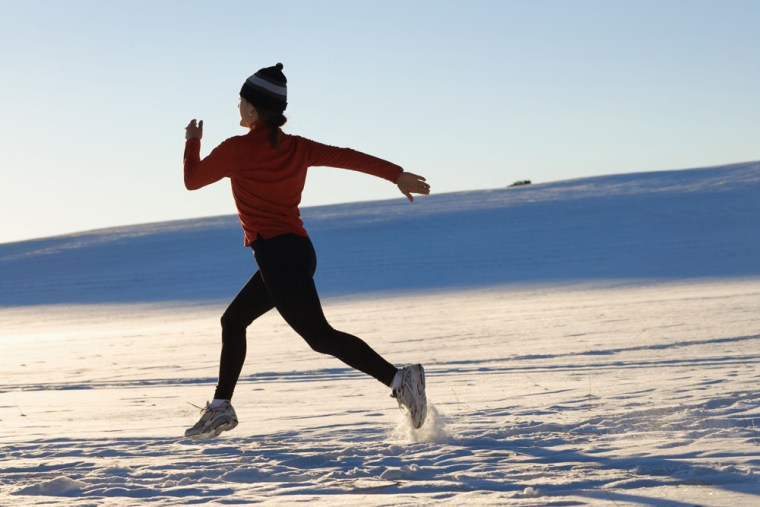Unable to get the swine flu vaccine in her area, Demi Knight Clark has been hoping exercise will help to keep her healthy this winter.
After working out on and off for several years, Clark, 32, of Fort Mill, S.C., decided to commit to a regular exercise program this summer to boost her health and ease work stress. Since then, she’s been doing yoga, including power yoga, about four days a week and Pilates on another two.
Swine flu has been going around her community, and when her two young children came down with fevers and other flu-like symptoms last month, “I flew right through it,” says Clark, who runs her own public relations and marketing firm.
In fact, since sticking with a fitness routine, she’s never felt better. “I feel like I’ve got a suit of armor on,” she says.
Studies have concluded that exercise can enhance the immune system, but is the effect great enough to stave off swine flu?
While researchers haven’t studied exercise and swine flu specifically, they have explored whether physical activity can enhance immunity and combat colds and, to a lesser extent, seasonal flu. Their findings suggest that moderate physical activity can help boost immunity but that extreme exercise can weaken the body’s defenses.
“There is evidence that moderate exercise or physical activity can be beneficial in terms of reducing the incidence and severity of upper respiratory tract infections from all causes,” says Jeffrey Woods, a professor of kinesiology and community health at the University of Illinois at Urbana-Champaign. “And at least one report … has shown that exercise may be protective against influenza-associated [deaths] in the elderly.”
Woods recently published an article in the journal Exercise and Sport Sciences Reviews that summarized the research to date on the impact of exercise on the common cold and flu.
One study, for instance, followed 547 healthy adults ages 20 to 70 over the course of a year and found that compared with sedentary individuals, those who engaged in moderate to vigorous physical activity reduced their risk of upper respiratory tract infections by almost a quarter.
“The evidence seems pretty strong that folks who are moderately physically active have a somewhat higher level of protection,” says Michael Flynn, chair of the department of health and human performance at the College of Charleston in South Carolina, who also has studied exercise and immunity.
Don’t overexert yourself
The exception is people who train extremely hard, to the point of overtraining, or who compete in grueling endurance events such as marathons, Flynn notes. In these cases, people may be more susceptible to respiratory infections, at least temporarily, than those who don’t exercise at all.
Researchers aren’t clear on exactly how exercise might rev up the immune system. Woods’ laboratory work in animals suggests that moderate exercise can help by reducing the body’s inflammatory response to a respiratory virus, resulting in less illness severity and fewer deaths, at least in animals.
Experts agree that more human studies are needed to clarify the role of exercise in preventing or reducing the severity of colds and flu. But such research can be difficult and even unethical to do because people, understandably, aren’t eager to be voluntarily exposed to colds, and certainly not the flu, in the kinds of studies that would provide more definitive answers.
If it's intuitive that healthy and fit people will recover more quickly from flu, is it also correct to think that unhealthy people might be more susceptible? Perhaps, according to doctors who have made anecdotal observations about who's hardest-hit by swine flu.
Obese people, for instance, seem more at risk for flu-related pneumonia and other complications and slower recoveries, says Dr. William Schaffner, chair of the department of preventive medicine at Vanderbilt University in Nashville.
Still, about a third of people who develop serious complications from swine flu were perfectly healthy beforehand, Schaffner points out. “This is an illness that can afflict a very healthy child or adult and make them very sick,” he says.
The other two-thirds have underlying illnesses such as diabetes, heart disease, lung disease or compromised immune systems, he notes.
So while there are “bits and pieces of evidence that exercise enhances the immune system,” it’s not clear if the effect is strong enough to effectively battle the likes of swine flu, Schaffner says.
“Relying on it completely is not a good bet,” he says.
Woods agrees that moderate exercise should be viewed as an adjunct to other preventive measures against respiratory viruses, including the H1N1 virus that causes swine flu.
“First and foremost, if you have a chance to get the vaccine, get it,” says Woods. Also be sure to take other recommended precautions, such as washing your hands and avoiding sick people.
But should you also steer clear of the gym? Could going there to help keep you healthy and protect against the flu backfire if you’re picking up the very germs that cause it?
It’s true you could get sick at the gym. But there’s no reason to think the gym is any more risky than other places where people congregate, says Schaffner. “The group at the gym isn’t a whole lot different than the group at the office,” he says.
People who are sick with the flu aren’t likely to be clocking many miles on the treadmill anyway. Still, people can spread respiratory viruses before they develop symptoms, so be sure to wipe off the machines and seats before (and after, to protect the next person) you use them, advises Schaffner, and use plenty of hand sanitizer.
And if another exerciser is coughing or looking ill, he says, play it safe and “work out at the other side of the gym.”
Clark, the yoga and Pilates devotee, isn’t too worried.
“After all,” she says, “how many sick yogis do you see?”
